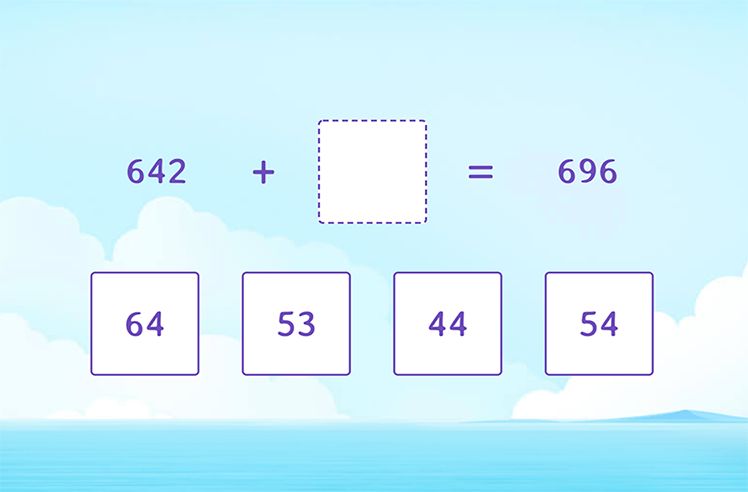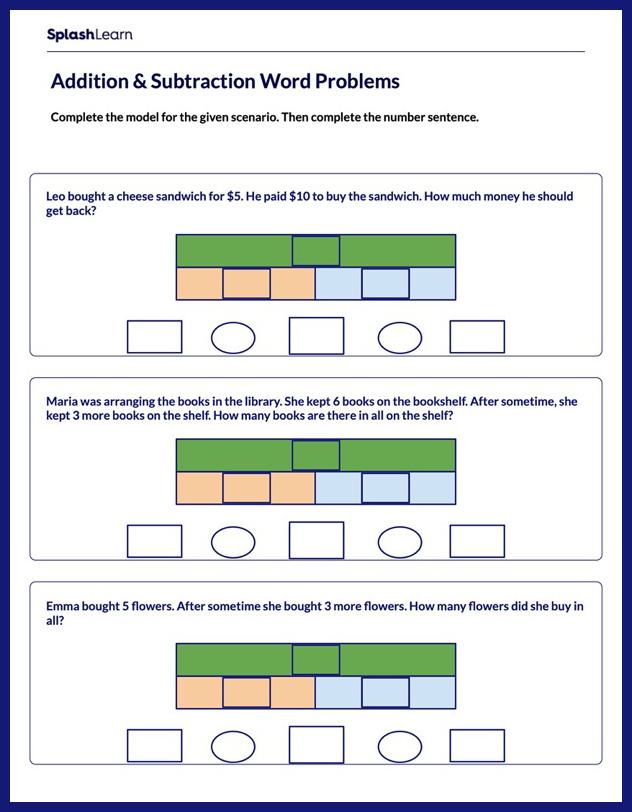What Is a Linear Equation?
A linear equation or one-degree equation is the equation with degree 1. The degree of an equation is the highest power of variables present in the equation.
Linear equation is an algebraic equation in which the highest degree of a variable is 1. How can we know if an equation is linear? No variable in a linear equation has an exponent or power greater than 1. They are called linear equations since the graph of a linear equation in one or two variables always forms a straight line.
We can write linear equations in different ways, depending on the number of variables present. For example, a linear equation in one variable can be written in the form ax + b = 0, where a, b, and c are real numbers and x and y are variables with the highest power 1.
Examples of a linear equation:
- $y = 2x$
- $x + y = 2$
- $y = 3x \;-\; 2$
Non-examples of a linear equation:
- $y^{2} = 3x$
- $y^{3} = 2 + x$
Recommended Games
Definition of a Linear Equation
A linear equation is an algebraic equation in which each variable term is raised to the exponent or power of 1.
A linear equation in one or two variables always represents a straight line when graphed.
Example: $x + 2y = 4$ is a linear equation and the graph of this linear equation is a straight line.
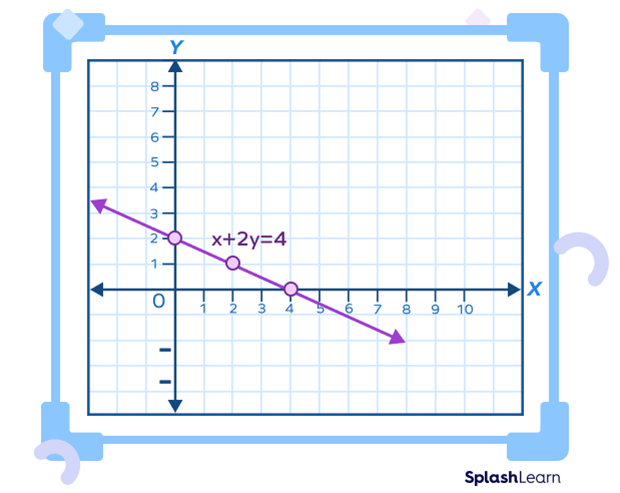
Recommended Worksheets
Linear Equation in Standard Form
Linear equations are a combination of constants and variables.
Linear equation in one variable has the standard form $Ax + B = 0$, where A and B are constants (A≠0), x is the variable.
A linear equation in n variables $x_{1},\;x_{2},\; …,x_{n}$ is of the form
$a_{1}\;x_{1} + a_{2}\;x_{2}$ … $+ a_{n}\;x_{n} = c$
where
$x_{1},\; …, x_{n}$ are variables,
coefficients $a_{0},\; …,\; a_{n}$ are constants (not all zero),
c is a constant,
a1 is the leading coefficient,
x1 is the leading variable.
Linear Equations in One Variable
The standard form of linear equations in one variable is given by
$Ax + B = 0$
where A and B are real numbers and $A \neq 0$
x is the variable.
It has only one solution.
Example of linear equation in one variable: $5x + 3 = 0$
Linear Equations in Two Variables
The standard form of linear equations in two variables is given by
$Ax + By + C = 0$
where A, B, and C are real numbers and $A neq 0,\; B \neq 0$
x and y are the variables.
A linear equation in two variables has infinitely many solutions. Every solution of
a linear equation can be represented by a unique point on the graph of the equation.
Example of linear equation in two variables: $2x + 7y + 3 = 0$
Linear Equation Formulas
As mentioned earlier, a linear equation in one variable or two variables represents a straight line. We can write the equation of a line in different forms. The formula for linear equations refers to the standard form, slope-point form, slope-intercept form, etc.
General Form (Bold)
A linear equation in two variables forms a straight line. Its general form is given by
$Ax + By + C = 0$
A, B, C are constants.
A and B cannot both be 0 simultaneously.
Slope Intercept Form (Bold)
Linear equations can be written in a simple slope-intercept form as $y = mx + b$, where x and y are the variables, m is the slope of the line, and b is the y-intercept.
Example: Equation of a line with slope 5 and y-intercept 2 is $y = 5x + 2$.
Slope Point Form (Bold)
The slope of a line having slope m and passing through a point (x1,y1) is given by
$y \;−\; y_{1} = m(x \;−\; x_{1})$ where $m = slope$
Example: Slope of a line $= 4$, Given point on the line $= (1,\; 2)$
Equation: $y \;−\;2 = 4(x \;−\;1)$
How to Graph Linear Equations
Graphing linear equations is a simple process. The graph of a linear equation in one variable or two variables forms a straight line.
A linear equation in one variable x forms a vertical line that is parallel to the y-axis.
A linear equation in one variable y forms a horizontal line that is parallel to the x-axis.
Let’s understand how to graph the linear equations with examples.
Example 1: x – 8 = 0 is a linear equation in one variable.
Isolate x by adding 8 to both sides of this equation.
$x \;-\; 8 + 8 = 0 + 8$
$x = 8$
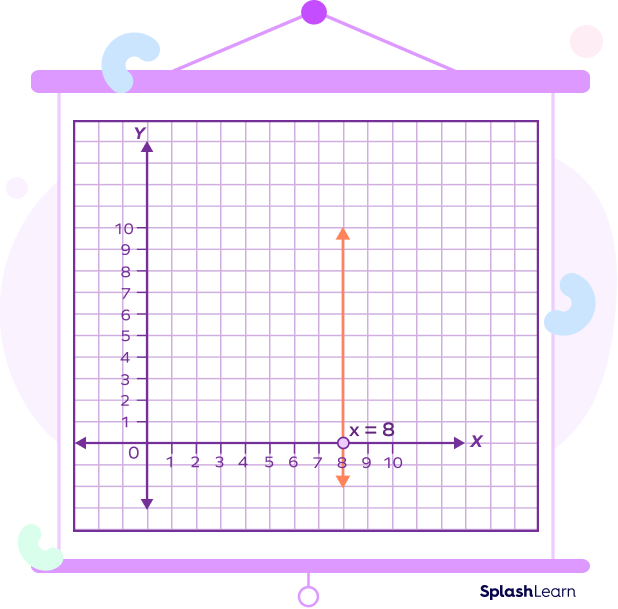
Example 2: Plot a graph for a linear equation in two variables:
$4x \;-\; 2y = 8$
Let us plot the linear equation graph using the following steps.
Step 1: Convert the equation in the form of $y = mx + b$.
This will give: $y = 2x \;-\; 4$.
Step 2: Put $x = 0$ in the equation to get the y-intercept.
We get $y = 0 \;-\; 4 = \;-\;4$
Similarly, if we substitute $y = 0$, we get the x-intercept $x = 2$
(Note that you can replace the value of x for different numbers and get the resulting value of y to create the coordinates. Once you get two points, you can draw a line passing through these points.)
List the coordinates of points that satisfy the given linear equation $y = 2x \;-\; 4$ as shown in the following table. Only two points are enough to graph the line.
Here are the ordered pairs that satisfy the given linear equation.
| x | 0 | 2 | 4 | $\;-\;2$ |
| y | $\;-\;4$ | 0 | 4 | $\;-\;8$ |
Plot these points on a graph and draw a line passing through these points.
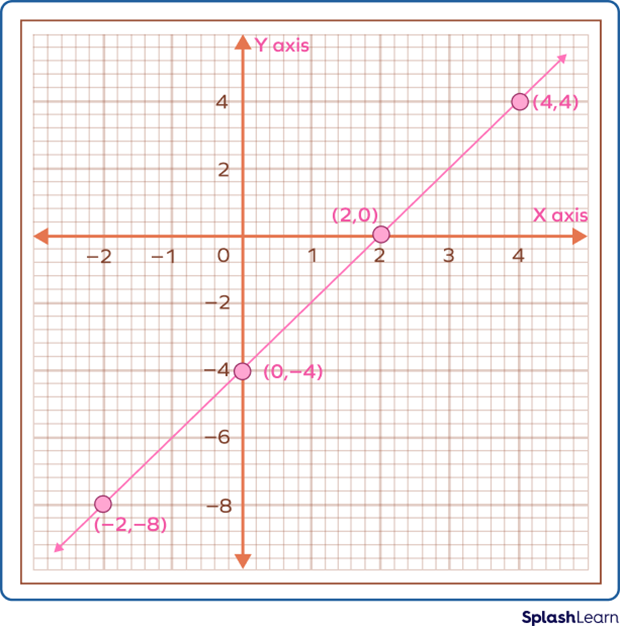
How to Solve Linear Equations in One Variable
The value of the variable that satisfies the linear equation is called the solution of the linear equation. An equation is a mathematical statement in which the left hand side (L.H.S.) is equal to the right hand side (R.H.S.). Different properties of equality are used to solve algebraic equations.
We isolate the variable or bring the variables to one side of the equation and the constant to the other side and then find the value of the unknown variable by simplifying. This is the method of solving linear equations in one variable.
Example: Solve the linear equation $5x \;-\; 12 = 18$.
Step 1: Add 12 on both sides.
$5x \;-\; 12 + 12 = 18 + 12$
$5x = 30$
Step 2: Divide both sides by 5 to isolate x.
$\frac{5x}{5} = \frac{30}{5}$
$x = 5$
Thus, we have $x = 5$. This is one of the methods of solving linear equations in one variable.
How to Solve System of Linear Equations
A system of linear equations consists of two or more linear equations made up of two or more variables such that all equations in the system are considered simultaneously. A system of linear equations in two variables can be solved using different methods like substitution, graphing method, matrix, cross multiplication, etc.
Let’s understand the simplest method—the substitution method—with an example.
Example: Solve the system of linear equations in two variables.
$y = 3x\;-\;1$
$4x + y = \;-\; 8$
Solution:
Consider the first equation: $y = 3x\;-\;1$.
Substitute the value of y from this equation into the second equation $4x + y = \;-\;8$.
$4x + 3x\;-\;1 = \;-\;8$
$7x = \;-\;7$
$x = \;-\; 1$
Put $x = \;-\;1$ in the first equation $y = 3x\;-\;1$.
$y = 3(\;-\;1)\;-\;1=\;-\;5$
Thus, we get $x = \;-\;1$ and $y = \;-\;5$
Facts about Linear Equations
- Linear equation is defined as an equation of degree one.
- The graph obtained from a linear equation is always a straight line.
- The value of the variable that makes a linear equation true is called the solution or root of the linear equation.
- The solution of a linear equation is unaffected if a balanced operation of addition, subtraction, multiplication or division is performed on both sides of the equation.
- The graph of a linear equation in one or two variables always forms a straight line and it can be extended indefinitely in both directions.
Conclusion
In this article, we learned linear equations, their standard form, formulas associated with linear equations. We also learned how to graph linear equations. Let’s solve a few examples and practice MCQs for more clarity.
Solved Examples on Linear Equations
1. Solve for x: $\frac{2x + 5}{3} = x \;-\; 5$.
Solution:
$\frac{2x + 5}{3} = x \;-\; 5$
Multiply both sides of equation by 3
$\frac{2x + 5}{3} \times 3 = (x \;-\; 5)\times 3$
$\Rightarrow 2x + 5 = 3x \;-\; 15$
Subtract 5 from both sides of equation
$\Rightarrow 2x + 5\;-\;5 = 3x \;-\; 15\;-\;5$
$\Rightarrow 2x = 3x \;-\; 20$
$\Rightarrow 2x \;-\; 3x = \;-\; 20$
$\Rightarrow \;-\; x = \;-\; 20$
$\Rightarrow x = 20$
2. The sum of two numbers is 55. If one number is 11 less than the other, find the numbers by framing a linear equation.
Solution:
Let the first number be x.
Then the second number is $x \;-\; 11$.
According to question,
$x + x \;-\; 11 = 55$
$\Rightarrow 2x \;-\; 11 = 55$
Add 11 to both sides of the equation.
$\Rightarrow 2x \;-\; 11 + 11 = 55 + 11$
$\Rightarrow 2x = 66$
Divide both sides by 2.
$\Rightarrow x = 33$
Therefore, $x = 33$ is the first number.
Second number $= 33 \;-\; 11 = 22$.
3. Solve the given linear equation: $4x + 92 = 72$.
Solution:
Given equation: $4x + 92 = 72$
Add $\;-\;92$ on both sides.
$\Rightarrow 4x + 92 \;-\; 92 = 72 \;-\; 92$
$\Rightarrow 4x = \;-\;20$
Divide both sides by 4.
$\Rightarrow \frac{4x}{4} = \frac{\;-\;20}{4}$
$\Rightarrow x = \;-\;5$
4. Five times of a number is equal to 45. Form a linear equation and find the unknown number.
Solution:
Let the unknown number be x.
Five times of this number is equal to 45.
$5x = 45$.
So, the linear equation is $5x = 45$
Divide both sides by 5.
$\Rightarrow \frac{5x}{5} = \frac{45}{5}$
$\Rightarrow x = 9$
Therefore, the unknown number is 9.
5. Solve the equation $8 \;–\; 2x = 12 \;–\; 4x$, and verify the result.
Solution:
Given equation: $8 \;–\; 2x = 12 \;–\; 4x$
Subtract 8 from on both sides of the equation.
$8 \;–\; 2x \;–\; 8 = 12 \;–\; 4x \;–\; 8$
$\Rightarrow \;–\; 2x = 4 \;–\; 4x$
Transpose $-\;4x$ to left side
$\Rightarrow \;–\; 2x + 4x = 4$
$\Rightarrow 2x = 4$
Divide both sides by 2
$\Rightarrow x = 2$
Verification:
Put $x = 2$ in the equation
$8 \;–\; 2x = 12 \;–\; 4x$
$\Rightarrow 8 \;-\; 2 x (2) = 12 \;-\; 4 x (2)$
$\Rightarrow 8 \;-\; 4 = 12 \;-\; 8$
$\Rightarrow 4 = 4$
Hence, LHS $=$ RHS.
Practice Problems on Linear Equations
Linear Equations - Definition, Graph, Examples, Facts, FAQs
Which of the following is NOT a linear equation?
$x^{2} + y = 5$ is a quadratic equation, as the highest degree of variable x is 2$.
What is the slope of the line whose equation is $y \;-\; 2x = 12$.
Given equation is $y\;-\;2x = 12$.
$\Rightarrow y\;-\;2x = 12$
Compare this linear equation with $y = mx + b$.
$\Rightarrow m = 2$
Therefore, the slope of the line is 2.
What is the value of x in the given linear equation $4x + 6 = 5x \;-\; 8$?
Given equation: $4x + 6 = 5x \;–\; 8$
Subtract 6 from both sides of the equation.
$4x + 6 \;–\; 6 = 5x \;–\; 8 \;–\; 6$
$\Rightarrow 4x = 5x \;–\; 14$
$\Rightarrow 14 = 5x \;-\; 4x$
$\Rightarrow 14 = x$
Jenny's father’s age is 4 times Jenny's. If the sum of both ages is 40, what is Jenny's age?
Let Jenny age is x years.
Jenny father’s age $= 4x$
$4x + x = 40$
$\Rightarrow 5x = 40$
$\Rightarrow x = 8$
Hence, Jenny's age is 8 years.
Solve the linear equation in one variable: $7x + 6 = 13$
$7x + 6 = 13$
$\Rightarrow 7x + 6 \;-\; 6 = 13 \;-\; 6$
$\Rightarrow 7x = 7$
$\Rightarrow \frac{7x}{7} = \frac{7}{7}$
$\Rightarrow x = 1$
Therefore, the solution of the equation $7x + 6 = 13$ is $x = 1$.
Frequently Asked Questions on Linear Equations
What is the graph of linear equations in one variable?
The graph of a linear equation in one variable is a straight line, either vertical or horizontal. The graph of linear equations in two variables is a straight line passing through x-axis or y-axis.
What is the use of linear equations in our daily life?
With the help of a linear equation, we can find the value of any unknown quantity, like: age, wages of an employee, doses of medicines, etc.
What is the meaning of the solution of a linear equation?
The solution of a linear equation is the value of the variable that satisfies the given linear equation.
How to know if an equation is linear?
- The degree of a linear equation is 1.
- There is no term involving the product of variables.
What are the parts of linear equations?
A linear equation consists of several parts such as variables, constants, coefficients, operators, equality sign (=), that play different roles in defining the equation and its properties.




















